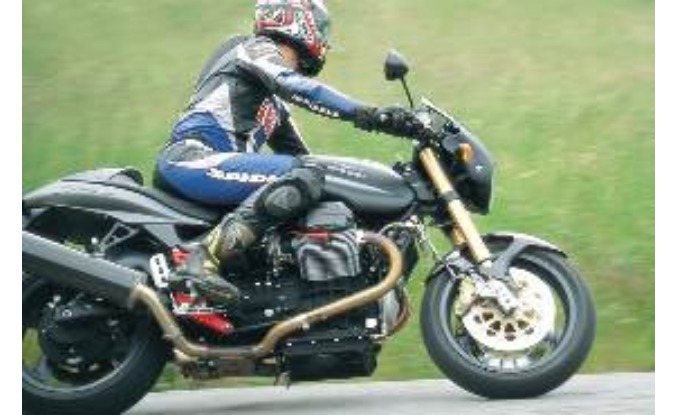Church of MO: 2002 Moto Guzzi V11 Scura
Normally we’d save this M-G review for next year, when it’ll be a nice, even 20 years old. But since it’s Moto Guzzi’s 100th anniversary this year, and since Yossef’s visit to the Mandello factory/museo to ride this one is as high-quality as MOtojournalism gets, we’re making an exception. Happy anniversary, Moto Guzzi. And happy Guzzi-ing, Yossef.
In which Yossef uses the C-word. (Character)
Even the meanest journalist, one who has not grown up on valve-dropping V50s and can’t tell a Falcone from a Galletto, would melt into a puddle under the sheer nostalgia overload that lands on the visitor to the Mandello del Lario factory. An early morning train from Milan transfers me within just one hour into another time dimension as I descend into the tiny and romantic train station of Mandello, an early century stone building that looks like it’s been taken straight out of a fairy tale book. At the far end of the station, huge and decaying loading ramps are silent reminders of the times when this factory was among the biggest in the world and churned out hundreds of bikes a day. A one-minute walk brings me to the gate of the factory, and while waiting inside for my test ride I suddenly have to rub my eyes in disbelief: In a nearby open garage, a dozen or so of Moto-Guzzi’s historic racers sit in a row, quietly reflecting the morning sunlight that filters in through the windows. The most exotic race bike ever built, Bill Lomas’s 500c.c. V8 GP machine, some pre-war GP V-twins, a few world championship winning 350 singles with their hand-beaten aluminum “dustbin” fairings. A friendly mechanic with a cigarette dangling from his lips (while strolling between the most prized classic bikes on earth) notices my unbelieving stares, and without blinking asks me: “Wanna try them for size?”.
And so, while I find myself seated on Omobono Tenni’s 1937 Isle of Man Senior race winner, enjoying its Swiss clockwork delicacy and half-century patina, this mechanic decides to push me along an internal road so that I will be able to feel the feathery steering of the bicycle like 3.00″-section tires. Can you imagine such a scene at Honda HQ in Japan? Yeah, go and write an honest road test after such a personality altering experience, Guzzi fan or not. This is plain bribery, a real scandal, I bet it was all planned beforehand. I’ll soldier on just the same.
A short history lesson is due. For the last 35 years Moto-Guzzi has been producing their big bore, across the frame V-twins, BMW’s of sorts but with a 90 degree angle between the twin towering cylinders. As unreal as it might sound, the 2002 V11’s engine is a straight descendant of this long dynasty. Mechanically, this family of engines which started as a failed project for Fiat car power units, hasn’t changed much since the Ice Age. The family of V’s was born in `67 as a 700, was seriously updated in `71 when the classic V7 Sport came out, received its “square” looks with the launch of the LeMans III of `81, and that’s about it. There have been displacement increases, 844, 949 and lately 1064–but no major mechanical changes.
So while even slow moving giants such as H-D and BMW update their stuff every 15-20 years, Guzzi engines have remained essentially the same for three decades (save for the eight-valve 992 which saw service in the Daytona but isn’t in production at the moment). As it turns out, major re-dos weren’t exactly needed. As amazing as it might sound, in dyno testing, the old dinosaur that is the current two-valve-per-cylinder, 1064 mill of the V11, churns out close to 80 rear wheel horsies, giving an even fight to BMW’s modern four valve per cylinder 1150cc unit. More than honorable for such an old lady and living proof of the basic virtue of Guzzi’s V-twin.Those big cylinders sticking out beneath the fuel tank might look exactly the same as those on my `81 LeMans Mk III, but around the pre-historical engine there are very few age-related accessories. A six-speed gearbox was mated to the V11 when the model was launched back in `97, and full digital engine management (injection and ignition) was a Guzzi trademark long before being adopted by other makers.
The V11’s frame is based on the design penned by American dentist, Dr. John Wittner back in the good old eighties. The V11’s Dr.John-inspired frame is built around a main rectangular section tube that runs straight from the steering stem tube between the cylinders to the area above the gearbox. A round cross tube spreads the structural loads to two bolt-on ears that hold the rear swing arm bearings. Clean and simple. At the back end, the swingarm holds a floating bevel drive case, thus canceling the unwanted compression of the rear suspension under engine braking–a well-known distraction to riders of shafties.The old vs. new theme continues with a fully up-to-date inverted fork and a rear triangular monoshock suspension that’s linkless, just like in an early eighties Yamaha. Oh yes, I almost forgot to say that I am about to ride a rather special version of the V11 Sport, the new for `02 “Scura” (Dark). In the fashionable matte black “Scura” version, top-of-the-line Ohlins suspension components replace the more mundane regular V11 items. There’s a titanium nitride coated fork up front, actually the same one as fitted to the Aprilia RSV Mille R, and ultra-adjustable Swedish damper in the back. Other expensive items that make the Scura stand out are carbon fiber side panels, front fender, tank top protector and mufflers. There is also a “Scura” bikini fairing and deluxe Ohlins steering damper.
And the thing is designed, too: Guzzi was among the first companies in the world to use professional designers, way back in the 60’s. Even with all my unconditional love for most things “made in Mandello”, I have to admit I had a hard time trying to digest the V11’s shapes. Designers seem to have tried to create a retro-cafe-racer and in many ways they actually succeeded, but there is something awkward about the fuel tank’s shape that disturbs the balance of the whole bike, at least in my eyes. It’s high at the rear, sharpens strangely at the front when looked at from above and creates a visual composition that failed to convince me even after a few days. Other body parts, on the other hand, are extremely sexy. The seat unit, especially when the rear seat cover is in place, is a masterful and modern interpretation of those classic and firm rear ends of Rocket Gold Stars and Vincents of yore. At the end of the day my main problem was the fact that the whole bike looks way too tall, hence reducing the visual presence of that bold & lovely engine.
And yet, the new composition has advantages too compared to the old models. Upon sitting on the bike, my knees stay farther away from the rocker covers, allowing me to sit in a much more modern feeling position. There is also more distance between seat and pegs and only the handlebars seem still to be a tad too far–but nothing like my old Lemon. Serious smiling begins after starting the thing and snicking into first gear. Gear changing on those old five-speed Guzzi boxes was a half hour long project that required some serious pre-planning and conveyed the feeling of moving around huge lead weights. In the V11’s “new” six-speed box, first gear slides in like the proverbial hot knife in butter. Just to make sure that it’s not the fairy tale atmosphere that’s twisting my perception, I play again with the lever. Neutral is so easy to find, lever so smooth, ooh, the marvels of modern technology…(Will they notice if I hand back the Scura with my bike’s gearbox?) The six-speed box can make any Guzzisti believe the Mesiah has arrived.
More by John Burns

































Comments
Join the conversation
I remember seeing a good few of these Scura's rumbling along the Crest or parked up at Newcombs early on, but then fewer and fewer and then none post-2010. Always loved the look, and I saw more than one being flogged along the Crest at a pretty good clip. It's been sad not seeing new liter sized guzzi's since Euro 4 put then on the sidelines to be replaced with the 750 and (now) 850 motors. So, good news about that V100. If they make a version that looks like the current V7 but with that V100 motor I'd get in line.
Someday you MOrons will have to compile a "Best of MO" catalog.
Make sure this review is in there.